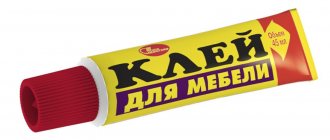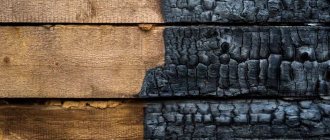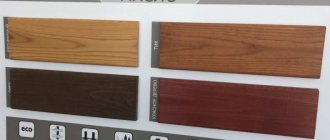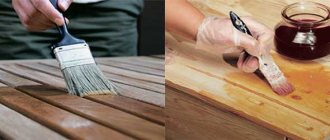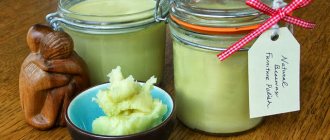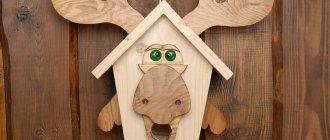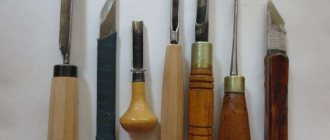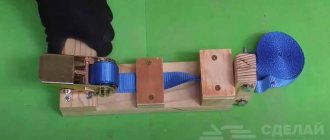| Place | Name | Characteristics in the rating |
| The best PVA glue |
| 1 | Kleiberit 303.0 | The most waterproof PVA glue |
| 2 | Krass PVA PVA D3 | The most transparent wood glue |
| 3 | Moment Joiner PVA Universal | The best domestic glue |
| The best polyurethane adhesives |
| 1 | Kleiberit 501.0 | The best all-purpose glue |
| 2 | SOUDAL 66A | Highest adhesion |
| 3 | Akfix PA370 D4 | Fast drying and excellent heat resistance |
| The best resin-based adhesives for wood |
| 1 | Titebond Original Wood Glue | The best professional glue |
| 2 | Uhu plus endfest 300 | The strongest glue |
| 3 | EDP epoxy glue | Best price |
| Modern synthetic based adhesives |
| 1 | Titebond III Ultimate Wood Glue 1415 | The most harmless glue |
| 2 | Quilosa Bunitex P-55 | Does not lose its properties over time |
| 3 | Forbo 650 Eurostar Fastcol | High fixation |
Advantages and disadvantages of different types of wood adhesives
| Glue type | Advantages | Flaws |
| PVA | + affordable price + environmental friendliness + versatility + ease of use | - insufficient strength - afraid of moisture — destroyed at high temperatures (+60°C) |
| Polyurethane | + high strength to dynamic loads + inert attitude to temperature changes + resistance to moisture + UV resistant | - high price - Strong smell |
| Based on organic resins | + connection strength + versatility of use + resistance to water and aggressive compounds + reasonable price | - skin protection required — high consumption - requires precise mixing of components |
Bioglue:
The global trend is to focus on environmentally friendly technologies that are not harmful to human health. Due to the lack of raw materials and high cost, natural adhesives are practically not produced. greater development abroad. The adhesive composition developed by Russian scientists— bioglue in its composition, production method and environmental safety is included in the group of adhesives of natural origin.
Bioglue is aimed at replacing toxic formaldehyde resin used in the production of wood and particle boards with fundamentally new, environmentally friendly and safe binders, which is exactly what it is.
At the same time, the production of bioglues is a technology for the biotechnological processing of food production waste in order to obtain environmentally friendly bioglues.
Bioglue is a viscous liquid, dark brown in color, with a faint smell of burnt sugar.
Bioglue is based on dextran, which is produced by harmless microorganisms (used in the food industry) as a result of the biotransformation of polysaccharides contained in organic food processing products (molasses, stillage and whey). Dextrans are polyglycosides synthesized from sucrose by microorganisms, as well as enzyme preparations isolated from cultures of the same microorganisms.
The best polyurethane adhesives for wood
Polyurethane adhesives are highly durable. Glued parts can be subjected to both static and dynamic loads. The seam is not afraid of moisture, sunlight, or temperature changes. Our review presents the best polyurethane products.
Titebond Polyurethane Wood Glue 2300
Rating: 4.9
A real breakthrough in the field of adhesive technology was the development of a polyurethane composition for wood, Titebond Polyurethane Wood Glue 2300. Experts unconditionally gave this product from the USA the first place in the rating. The manufacturer managed to find the optimal balance between pressing speed (45 min) and retention time of working properties (20 min). The glue perfectly bonds any wood-based materials, from natural wood to wood chip products. However, the scope of application does not end there; metal, plastic, ceramics, stone and a number of other materials can be permanently glued.
The product is water resistant, but it is not recommended to keep the knots formed in conditions with constantly high humidity or under water. The composition is not afraid of frost, but before use it should be warmed to +12°C.
Advantages
- fast gluing;
- versatility;
- high seam strength;
Flaws
- high price.
Wood gluing technology
Before starting work, it is recommended to stock up on all the necessary tools and protective equipment. Overalls, goggles and a respirator will protect the respiratory tract from harmful fumes, glue residues and wood dust.
Any wood glue will give excellent results if the surface is carefully leveled. Well-dried wood is sanded with fine sandpaper, cleaned of dust, and then degreased.
Wood of different types is glued together approximately the same way:
- The parts must be positioned horizontally so that the mass does not flow to one side. The glue is applied in a zigzag pattern to spread it freely over the surfaces;
- Working with two-component compositions is no different from other adhesive mixtures, only the base is applied to one contact wooden surface, the hardener is applied to the other;
- For better adhesion, wood glue is applied in a double layer, allowing the initial impregnation to dry a little. Next, these parts are connected and pressed tightly to enhance adhesion strength;
- When gluing, excess composition appears on the seams; they cannot be left until polymerization. In liquid form, the glue is much easier to remove. Depending on the density, the excess is cut off with a knife, removed with a sponge with a solvent, or wiped with a rag.
Any wood glue will give excellent results if the surface is carefully leveled.
Do I need to degrease surfaces?
Most offers on the consumables market are marked “Clean and degrease the surface.” Compliance with standards is the best prevention of poor-quality connections. It is important not only how to properly clean, but also how to degrease the surface. The main problem is to completely remove grease stains and resin pockets from coniferous wood.
Removing oily stains from wood is done with a soft cloth soaked in a suitable solvent. Mechanical cleaning and sanding with fine sandpaper of the area prepared for gluing wood is often required.
Removing oily stains from wood is done with a soft cloth soaked in a suitable solvent.
Rating of the best wood adhesives
| Nomination | place | Name of product | price |
| The best PVA wood glue | 1 | Kleiberit 303.0 | 291 ₽ |
| 2 | ULTIMA JOINER PVA | 129 ₽ | |
| 3 | Moment Super PVA D3 moisture resistant | 490 ₽ | |
| 4 | TEX PVA Carpentry Professional | 149 ₽ | |
| 5 | Krass PVA PVA D3 | 205 ₽ | |
| The best polyurethane adhesives for wood | 1 | Titebond Polyurethane Wood Glue 2300 | 385 ₽ |
| 2 | Kleiberit 501.0 | 477 ₽ | |
| 3 | SOUDAL 66A | 450 ₽ | |
| The best resin wood glues | 1 | UHU PLUS ENDFEST 300 | 503 ₽ |
| 2 | TITEBOND ORIGINAL WOOD GLUE | 480 ₽ | |
| 3 | EDP EPOXY GLUE | 250 ₽ | |
| 4 | Titebond III Ulimate 1416 | 590 ₽ |
The best PVA wood glue
One of the most environmentally friendly wood glues is a water emulsion of polyvinyl acetate. There is no toxic odor during work, so ventilation is not a mandatory requirement for a carpentry workshop. The availability of the product allows it to be widely used. Experts paid attention to several models.
Kleiberit 303.0
Rating: 4.9
German wood glue Kleiberit 303.0 has many advantages. But experts focused on such quality as water resistance. It was this fact that became the key in determining the winner of the rating. This PVA glue is also the leader in sales in our country. Consumers managed to appreciate the versatility of the adhesive composition. With its help, you can connect different types of wood, fiberboard, chipboard, veneer, etc. Some craftsmen admire working with hard wood. The gluing process itself does not cause any difficulties. It is enough to press the parts to be joined for 6...10 minutes to get a single whole.
In addition to moisture resistance, users note resistance to low temperatures (down to -30°C). The white color after drying also does not cause discomfort.
Advantages
- strength;
- ease of use;
- resistance to low temperatures;
- moisture resistance;
Flaws
- not detected.
Technical characteristics of the bioslab:
| Indicator name: | Meaning | Requirements for particle boards according to GOST 10632-2007 |
| Humidity, % | 5–10 | 5–12 |
| Thickness swelling %, (Tw*): | ||
| in 24 hours | <20 | 20 |
| in 2 hours | <12 | 12 |
| Ultimate strength at static bending, MPa, (Tn*) | 14–19 | 12–15 |
| Tensile strength perpendicular to the face, MPa, (Tn) | >0,3 | 0,3–0,4 |
| Specific resistance to pulling out screws, N/mm, (Tn): | ||
| made of plastic | 50 | 55–35 |
| from the edge | 41 | 45–30 |
| Formaldehyde content, mg per 100 g of dry board | 0,01** | <8 |
| Hardness, MPa | 30–50 | 20–40 |
| Density, kg/m³ | 650–780 | 550–820 |
* – Тн and Тв – lower and upper limits of indicators, respectively.
** – natural emission of formaldehyde from wood.
How to clean a surface from dried glue
Compliance with the technology guarantees strong bonding, but often smudges and sagging remain on the seams after drying under pressure. If you do not remove it in time, it will ruin the aesthetic appearance of the product.
The simplest household methods:
- Soak with acetone (varnish/varnish liquid) and sand;
- Use the “anti-glue” composition to soften the sagging;
- Heat the “Superglue Moment” with a hairdryer and scrape it off with a knife;
- Carefully remove rough stains with any cutter;
- Moisten a piece of rag with white spirit and wipe the contaminated area.
Among household solvents that can be used to remove PVA wood glue, medical alcohol, gasoline and acetic acid are well known. Carpenters do not use such methods. They have at their disposal special solvents, acids, and components for mixing compositions. They are also suitable for cleaning seams with exposed adhesive.
Among household solvents that can be used to remove PVA wood glue, medical alcohol, gasoline and acetic acid are well known.
Each wood glue has its own characteristics. Some compounds are not suitable for light-colored wood layers. Others will be optimal for layer-by-layer gluing or applying thin veneer to a furniture panel. When working with each of them, it is important to be aware of the “pros” and “cons”, to work carefully, avoiding contamination and rough deposits.
